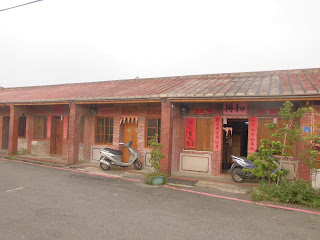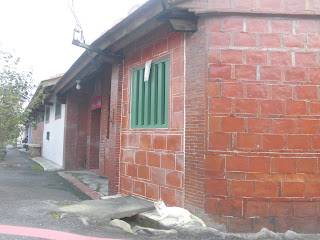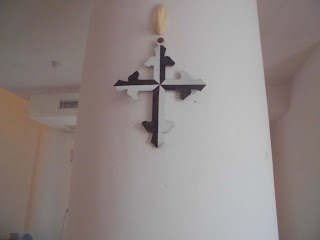繼續上次的旅行。我們還在五溝。
Continuing from last time, we're still in the town of Ooh Go. Let's check out some more houses.
前回の続き。まだ五溝にいる。
很厲害的宅第!
Oooh!
すごい邸宅が現れた!
上面的老鷹好酷!
Let's call this the eagle mansion, for the cool, stone eagle on top of the roof.
鷲が天辺に乗っている。
A long, low house.
鷲邸宅の隣りにこの低い家もある。
With tilework along the bottom.
Looking back at the eagle mansion.
振替って鷲邸宅を見た。
Close ups of the low-slung house.
Another place with a fancy gate and a courtyard.
三合院的房子
三合院式の家。
本地人
One of the locals.
地元のやつが路側でウロウロしよった。
什麼殘骸吧?
Something was here once.
何かの跡
就算古老氣氛這麼好的地方可是還是電線這麼多!
Electric wires everywhere.
電線が多過ぎ!
接下來我們去萬金。萬金有一座很有名的教會。在台灣當中較早宣教活動開始。今天是聖誕節所以剛好!
Pineapple fields and mountains as we head to a town nearby called One Jean. One Jean is the town I'm referring to in the post title. It has a famous, historic church in it. While Taiwan is majority Buddhist/Taoist, there is a significant percentage of the population that is Christian, especially amongst the various aboriginal people, some of whom started converting to Christianity back in the days of Dutch colonial rule.
It wasn't on purpose, but it's worked out that I finished this post just in time for Christmas!
はい、次は萬金という村に行く。(日本語の発音では恐ろしい名前になるね。マンもキンもある。)ポストタイトルに出てくる「キリシタンの町」はこの萬金。大きな教会がある。この村は昔からキリシタンが多かったそうだ。おそらく台湾の方が日本よりキリシタンが多いかもしれないが、それでも全体の人口からすれば多くない。だからこういうキリシタンの多い村はちょっと珍しい。単に、先住民の村に行ったらみんながキリシタンになっているのは普通だ。台湾の先住民は圧倒的にキリシタンだ。オランダの植民地時代から宣教活動があった成果である。
今日はクリスマスだからタイミングもいいね。
看起來普通的路邊地藏或是觀音,但是不是。是瑪麗亞!
It's noticeable that something is different in this town from the moment I arrive. There are roadside religious monuments like anywhere in Taiwan, but instead of
Gwan-In and
Dee-Tsahng statues, there are statues of Mary.
パッと見たら台湾のどこにでもある様な道の側にある観音とか、地蔵とかの仏像だけど、もう一回見たら、マリアだった!
教會看到了!
And there's the church!
教会が見えてきた。
Art
這座
教會很厲害。是一座
巴西利卡。台灣只有兩座而已!也算是在台現存教會當中最老的。1862年就已經建立起來了。
Some history of the church. (Click the photo to see a bigger version that you can actually read.) It is one of only two basilicas in Taiwan. I never knew this until I came here and read the signage, but a basilica is a special status that a Catholic church can receive if it is has a special history or whatever. I'm not Catholic, and I don't totally understand what the deal is, but it is at any rate special; and the Pope himself may have even signed off on it. (I dunno, seems likely.)
1861年にスペインのドミニカ派の宣教師がやってきた。1862年に土地を買って教会を建てた。でも1865年に地震によって崩れてしまった。1869年にグラウンドを拡大して、今の様な建物を建てた。この教会は台湾の現存教会の中で一番古いものだそうだ。しかも
バシリカだ。私もここに訪れて初めて知ったけど、バシリカというのはカトリック教の特別な位のある教会のことだ。台湾にはバシリカが二つしかないから、結構大したもんだ。
I failed to take a photo of all of the explanation here, but they claim that the church here was very successful back in the day in bringing together all of the people in the area into one community, both Chinese immigrants and native people. It was not uncommon during the Ching Dynasty, when Taiwan was still being settled by Chinese people, for the new immigrants and the native people of Taiwan to not get along. They spoke entirely different languages and had different customs, so there were lots of chances for misunderstandings. This particular church managed to not only get a lot of aboriginal converts, but also a fair number of Chinese converts, and this gave the people in the area something in common. At least that's what the signs here said.
The church has been repainted pretty recently.
雖然不是佛教或是道教的廟可是這座教會還是有「奉旨」的石碑!應該這樣的教會蠻少吧。這個意思是天皇承認這座教會是很重要的宗教機關。
The stone block with Chinese letters below the cross is interesting too. Apparently this church was a big enough a deal that it received special recognition from one of the Ching emperors back in the day. This stone block meant that imperial soldiers who travelled in front of this church were required to dismount when they passed in front of the entrance. (I think that was the ceremony. There may have been more to it, but I don't remember the details.) This kind of honor was more commonly reserved for particularly important Taoist, Confucian or Buddhist temples--in other words, for the "native" religions of China--and I think it was probably unusual for a Christian church to receive this kind of honor from the Ching government, a government that was not always friendly towards foreign missionaries.
十字架の下の「奉旨」にも面白い話がある。この辺の宣教活動があまりにも成功して、教会があまりにも立派で、清朝時代に天皇から認めてもらった。普通はこういう「奉旨」が書いている石碑は立派な道教とか仏教とかの廟の前に設置してある。玄関の前を通過する人は必ず馬から降りないといけないみたいな義務があったそうだ。でもこういう石碑が教会にあるのは珍しいと思う。西洋の圧力を感じた清朝はあまりキリシタンに対していい思い出はしなかったと思う。
Inside
瑪麗亞
Mary
マリア
從二樓的風景
The view from the bell tower.
二階からの景色
Some preserved architectural features.
"The bell is for informing the community of deaths, religious events and fires. Don't you be playing around and ringing it!"
「鐘は葬式、儀式、火事などを通達するためにある。絶対鐘で遊ぶな。」
Some religious text in Chinese.
聖書かな?
The main hall again, but from the peanut gallery this time.
建築大概是西洋的,但這些魚是常常在台灣傳統建築看到的。
I thought it was interesting how, despite that overall western architecture of the church, it still has these fish-shaped rain gutters, which are very common on traditional buildings in Taiwan.
教会の建築はほとんど西洋式だけど、この雨水を払う魚はとても台湾式なものだ。
Mary again. I've encountered Japanese people (Japan is a country with very few Christians) who were under the impression that the Christian god is Mary. After visiting a Catholic church, I can see why they would think that.
我不是天主教(也不是基督教)可是因為我在美國長大,所以我有一點點對這種宗教的知識。我覺得看到這些「我信」的標語有趣。看它們,有一些我有聽過。
Some of these photos are a little blurry, but I'm posting them anyway because I thought it was interesting to see these ideas written out in Chinese. It's a series of 12 ideas that all start with "I believe". While I'm not Christian myself, growing up in the US means that I was exposed to Christian thought and principles to some extent, so I actually recognize some of these ideas. This one says "I believe in forever life. Amen." "Amen" is literally just a phonetic transliteration of the sounds "ah" and "men". I guess "forever life" refers to going to heaven after death or something? Or maybe the post-apocolyptic kingdom of God on earth? Isn't there a thing like that?
中国語でキリシタンの信じないといけないことが書いてある。私はキリシタンじゃないけど、アメリカで育ったからある程度馴染みがある。というか、「ああこの概念聞いたことあるね」って感じ。だからそれを中国語で見るのはちょっと斬新だった。ちなみに「阿們」は「アーメン」のこと。
"I believe in the resurrection of the flesh."
"I believe in the forgiveness of sin."
"I believe in the church through which all that is holy passes." I think I may have totally mistranslated this one.
8: "I believe in the holy spirit."
7: "I believe that after 'that day' there will be judgement of all people living and dead."
西班牙人建立的所以好像還是有西班牙關係。
This is Spanish, right? This church was originally founded by a Spanish Dominican missionary.
スペイン語(だと思う)。教会を建立したのはスペイン人だからだろう。
聖道明
Saint Dominicus
聖ドミニコ
有一些石像說耶穌被殺了的話。
There was a series of statues gruesomely depicting the whole cross story.
イエスが十字架に上げられた話が石像によって描かれている。
到了這邊步道變成小小的石頭做的。因為這裡說耶穌的辛苦,所以我覺得應該是有人會把鞋子脫下來在石頭上走,用自己的身體來體驗辛苦,更認為耶穌的。
You can walk around a path and look at the story of Jesus being put on the cross, and when you get to this part, the path is made of lots of rocks. I think the idea is that you can take off your shoes and walk across the rocks and experience pain while reading about Jesus being hung on the cross and suffering. The rocks are right at the penultimate part of the story, so it's probably the part that was most painful for Jesus. I've read about Catholic festivals in some parts of the world that involve people putting nails through their own hands and whatnot (I think the Philippines is big into this) so it seems like this kind of personal experience of pain in order to get closer to Christ must be a Catholic thing.
ここでは歩道がいきなり石になっている。話の中ではここはイエスが一番苦しんでいたところ。同感するために石が設置されたと思う。靴を脱ぎ、ここ歩いて痛みを感じるのはイエスの痛みを理解するための儀式だと思う。(推測だけどね。)
In the center of the photo we have "Hallelujah" in Chinese characters. So now you know how to write it. (Like "Amen" above, it's also a phonetic transliteration.)
ハレルヤの漢字:「阿肋路亜」
"Jesus Cafe" I imagine the menu is pretty simple. "Lunch: Body of Christ" "Drinks: Blood of Christ" "Dessert: Cheesecake. But while you eat it you should think about how Jesus suffered on the cross for
your sins. Does it taste good?"
イエス食堂
又碰到瑪利亞。掰掰!
Mary at night. At one of the entrances to town.
村を出てマリアをもう一回見かける。

































































































































